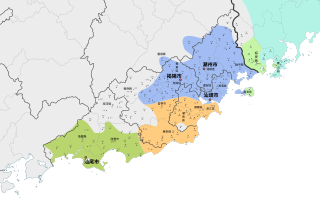Haklau Min
You can helpexpand this article with text translated fromthe corresponding articlein Chinese.(June 2011)Click [show] for important translation instructions.
|
| Haklau | |
|---|---|
| Hai Lok Hong, Hailufeng | |
| Phúc lão lời nói / phúc lão lời nóiHok-láu-ōe Hải lục phong lời nóiHái-lio̍k-hong-ōe | |
| Region | Mainly inShanwei,easternGuangdongprovince. |
Native speakers | 2.65 million (2021)[1] |
Early forms | |
| Language codes | |
| ISO 639-3 | (hlhis proposed[5]) |
| ISO 639-6 | hife |
| Glottolog | None |
| Linguasphere | 79-AAA-jik (Haifeng) 79-AAA-jij (Lufeng) |
 Haklau Min inShanwei | |
| Haklau Min | |||||||||||||||||
|---|---|---|---|---|---|---|---|---|---|---|---|---|---|---|---|---|---|
| Traditional Chinese | Hải lục phong lời nói | ||||||||||||||||
| Simplified Chinese | Hải lục phong lời nói | ||||||||||||||||
| |||||||||||||||||
Haklau,also known asHai Liok Hong Ue,Haifeng dialectorHailufeng Minnan.[6]It is a variety ofSouthern Minspoken inShanwei,Guangdongprovince,China.While it is related toTeochewandHokkien,its exact classification in relation to them is disputed.[7][8]
Etymology
[edit]In Guangdong, non-Min speakers refer to Min speakers as "hoklo"or"hoklau"(Luhe Hakka: /hok lou/;Teochew Min:/hok lau/; Haifeng Min: /hak lau/). At first it was a derogatory term, but after the 21st century it shifted to a neutral term and was accepted by localShanweipeople, but overseasShanweipeople still don't like the appellation.[9]
Historically, the Hai Lok Hong region was not a part of Teochew prefecture (Triều Châu phủ,the region currently known asTeo-SwaorChaoshan), but was included in the primarilyHakka-speaking Huizhou prefecture (Huệ Châu phủ). ModernHuizhoucity (particularly theHuidong County) also has a Haklau-speaking minority.
The wordHai Lok Hong(Hải lục phongHái-lio̍k-hong) is aportmanteauofHai Hong(Hải phong,MandarinHaifeng), Liok Ho(Lục hà,MandarinLuhe) andLiok Hong(Lục phong,MandarinLufeng), where it is mainly spoken. The character lục has multiple pronunciations in Southern Min: the readingle̍kis vernacular, it is common in Teochew, but rarely used in Hokkien and Hai Lok Hong itself; the readinglio̍k(Hokkien, Hai Lok Hong) orlo̍k(Teochew) is literary and commonly used in Hokkien and Hai Lok Hong, but not Teochew, yet its Teochew rendering is the source of EnglishHai Lok Hong.
Classification
[edit]TheLanguage Atlas of Chinaclassifies Hai Lok Hong as part ofTeochew.[10]Other classifications pinpoint the phonological features of Hai Lok Hong that are not found in Teochew, but instead are typical forChiangchew Hokkien.These features include:[11]
- the final /-i/ in characters likeCáhî'fish',Ngữgí'language', and the final /-u/ inTựchū'self',Sựsū'matter', as in Chiangchew Hokkien. Northern Teochew has /-ɯ/ in these words, while Southern Teochew (the Teoyeo dialect) has them with /-u/.
- the final /-uĩ/ in words likeMônmûi'door; gate',Quangkuiⁿ'light'. Teochew has them with /-ɯŋ/ or /-uŋ/.
- the finals /-e/ (Ngồichě'to sit',Đoảnté'short'), /-eʔ/ (Tiếtcheh'festival',Tiệtche̍h'to cut') and /-ei/ (Gàkei'chicken',Phốkei'street'), as in rural southern dialects of Hokkien (such asZhangpu,Yunxiao,orChawan), corresponding to Teochew /-o/, /-oiʔ/ and /-oi/. Conservative Northern Hokkien dialects have these words with /-ə/, /-əeʔ/, and /-əe/ respectively.
- the preservation of the codas /-n/ and /-t/ (as inDânmîn'people; nation' andCốtkut'bone'), which are merged with /-ŋ/ and /-k/ in most dialects of Teochew.
Still, Hai Lok Hong also has features typical for Teochew, but not Hokkien, such as:
- the preservation of 8 tones, pronounced similarly to Northern Teochew. Most dialects of Hokkien only have 7 citation tones.
- the final /-uaŋ/ inHuốngkhuàng'situation',Vongbuâng'to perish', which has merged with /-oŋ/ in Hokkien.
- less extensive denasalization: Hai Lok Hong and Teochew differentiate betweenNghịchnge̍k'to go against' andNgọcge̍k'jade', orNghingî'suitable' andNghigî'doubt', while in Hokkien, these pairs are merged (ge̍kandgîrespectively).
Lexically, Hai Lok Hong also shares some traits with Teochew:Cáikâi'(possessive particle)',Áiàiⁿ'to want',Liếcthéi'to see' — compare HokkienHề--ê,BặcbehandXemkhòaⁿ.
Notes
[edit]References
[edit]- ^"Reclassifying ISO 639-3 [nan]: An Empirical Approach to Mutual Intelligibility and Ethnolinguistic Distinctions"(PDF).Archived fromthe original(PDF)on 2021-09-19.
- ^Mei, Tsu-lin(1970), "Tones and prosody in Middle Chinese and the origin of the rising tone",Harvard Journal of Asiatic Studies,30:86–110,doi:10.2307/2718766,JSTOR2718766
- ^Pulleyblank, Edwin G.(1984),Middle Chinese: A study in Historical Phonology,Vancouver: University of British Columbia Press, p. 3,ISBN978-0-7748-0192-8
- ^Hammarström, Harald;Forkel, Robert;Haspelmath, Martin;Bank, Sebastian (2023-07-10)."Glottolog 4.8 - Min".Glottolog.Leipzig:Max Planck Institute for Evolutionary Anthropology.doi:10.5281/zenodo.7398962.Archivedfrom the original on 2023-10-13.Retrieved2023-10-13.
- ^"Change Request Documentation: 2021-045".31 August 2021.Retrieved30 May2022.
- ^PENG, Zhigang. "A Study on the Phonetic and Lexical Features of Hailufeng Fulao Dialect".Văn hóa sáng tạo tương đối nghiên cứu(32).
- ^"Cháozhōuhuà pīnyīn fāng'àn / ChaoZhou Dialect Romanisation Scheme".sungwh.freeserve.co.uk(in Chinese and English). Archived fromthe originalon 2008-07-20.Retrieved2008-11-06.
- ^Campbell, James."Haifeng Dialect Phonology".glossika.Archived fromthe originalon 2007-08-14.Retrieved2008-11-06.
- ^"Thăm dò sán đuôi hải lục phong phúc lão ( hạc lão ) lời nói dân hệ".
- ^Language atlas of China (2nd edition),City University of Hong Kong,2012,ISBN978-7-10-007054-6.
- ^Phan gia ý; Trịnh thủ trị (2010-03-01)."Khu đông Lưỡng Quảng Mân Nam ngữ phân bố cập phương ngôn phiến phân chia".Đài Loan ngữ văn nghiên cứu.5(1): 145–165.doi:10.6710/JTLL.201003_5(1).0008.



